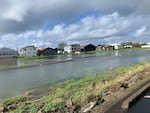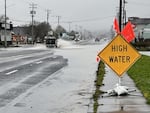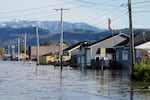
Flooding from the Salmon River in Otis, Oregon, on Nov. 12, 2021.
Kristyna Wentz-Graff / OPB
Damaging floods occur every year in Oregon and Washington, but some towns are at higher risk than others.
For example, five rivers flow into the Tillamook Bay— The Trask, Tillamook, Wilson, Kilchis and Miami. As a result, the shallow estuary on the Oregon Coast floods regularly.
In Portland, 35,000 properties are at risk of flooding over the next 30 years, according to First Street, an organization that links climate change and financial risk. That equates to 1.1% of buildings, which might seem high but local geography plays an important role. The closer a home is to a river, the more likely it is to flood.
For a granular picture of which buildings are at high flood risk, check in with your local city to see if they have a flood hazard map.
The City of Portland has a map where people can plug in their address to check their vulnerability.
The Federal Emergency Management Agency, or FEMA, has a similar address search function. Its maps show flood boundaries, hazard zones and areas of undetermined flood hazard.
The National Weather Service has a flood hazard map for Washington.

Scott Lane and Wendy Ackley submitted a photo to the Oregon King Tides Project last year, which shows the Pacific City State Airport flooded during king tides on Nov. 7, 2022.
Photo courtesy of the Oregon King Tides Project
Ways to minimize flood risk
- Keep gutters and storm drains clear of debris so water can flow freely.
- Use waterproof sealants to fill cracks and gaps in your foundation and walls.
- Store valuable items on high shelves and keep documents upstairs.
- Use sandbags around doors and windows.
- Elevate major appliances, like your fridge and water heater on concrete blocks or a pedestal.
- Install a basement sump pump with a battery backup to remove water during a power failure.
- Install non-return valves on drains and water inlets.
- Use permeable paving surfaces on driveways and pathways.
- Use ceramic tiles on the ground floor with waterproof adhesive and rugs instead of fitted carpets.

High water floods a portion of Highway 101 in Tillamook, Ore., Monday, Dec. 5, 2023, in this photo from the Oregon Department of Transportation.
Oregon Department of Transportation / X
Steps to take if your home floods
If your house floods, prioritize safety by evacuating everyone from the premises and turning off the electricity at the main source.
Other steps include:
- Turn off the main water valve and electricity to the house, avoiding walking through water to access the breaker panel.
- If possible, find the source of the flood water and try to stop it, like a burst pipe or leaking appliance.
- Take photos and videos of the flood damage throughout your home before starting any cleanup.
- Call your insurance company to report the flood and discuss coverage options.
- Start the clean up by removing standing water using pumps or wet/dry vacuums. Remove wet furniture, carpets, and belongings to prevent mold. Use fans and dehumidifiers to dry out the affected areas.
- Consider professional help.
- Do not enter flooded areas if electricity is exposed or if the water is deep and could compromise your safety.
- Wear protective gear: like gloves and boots when cleaning up floodwater.
- Be aware of potential hazards: like contaminated water and debris.
- Act quickly: to prevent mold growth which can occur within 24-48 hours of flooding.

Floodwater inundates homes along a road Wednesday, Nov. 17, 2021, in Sumas, Wash. An atmospheric river—a huge plume of moisture extending over the Pacific and into Washington and Oregon—caused heavy rainfall in recent days, bringing major flooding in the area. (AP Photo/Elaine Thompson)
Elaine Thompson / AP
Flood causes
Flooding can happen anywhere at any time. Weather events are commonly responsible. But changes in the environment, like new buildings or broken water mains can also be a problem.
Flood insurance covers many weather and infrastructure events including:
- River, lake or coastal water overflows.
- Heavy rainfall.
- Melting snow and ice in spring.
- Changes to the land, such as new buildings or burned trees after a wildfire.
- Water seeping through a levee or broken water main.
- Flood insurance can protect your property. But many policies do not cover flooding. The National Flood Insurance Program does cover flooding for homeowners, renters and businesses owners.
